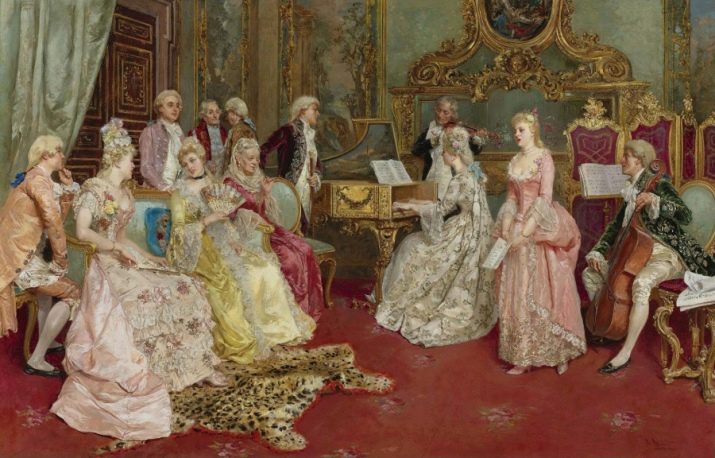Today, correct and cultural speech no longer occupies its former dominant position in society. Most people communicate without due respect and respect for each other, thereby causing misunderstanding, unnecessary quarrels and abuse.
If you adhere to certain norms of speech etiquette, then everyday communication will bring pleasure and joy, turning it into strong friendly ties, business contacts, and families.
Features
First of all, you need to find out what etiquette is. Summarizing most of the definitions, we can conclude that etiquette is a set of generally accepted rules regarding norms of behavior, appearance, and also communication between people. In turn, speech etiquette is a certain established linguistic norms of communication in society.
This concept appeared in France during the reign of Louis XIV. Special “labels” were handed out to the court ladies and cavaliers - cards where recommendations were written, how to behave at the banquet table, when the ball was held, foreign guests were solemnly welcomed, etc. In such a “compulsory” way the foundations of behavior were laid that eventually entered the common people.
From time immemorial to this day, in the culture of each ethnos there existed and exist their own special norms of communication and behavior in society. These rules help tactfully enter into verbal contact with a person without hitting his personal feelings and emotions.

Features of speech etiquette are in a number of linguistic and social properties:
- The inevitability of performing label forms. This means that if a person wants to be a full-fledged part of society (a group of people), then he needs to follow generally accepted norms of behavior. Otherwise, society may reject it - people will not want to communicate with it, maintain close contact.
- Speech etiquette is public politeness. It is always flattering to communicate with a well-mannered person, and it is especially pleasant to answer with a mutual "kind" word. Cases when people are unpleasant to each other, but ended up in the same team. Here, speech etiquette will help out, because all people want comfortable communication without swear words and harsh expressions.
- The need to comply with speech formulas. The speech action of a cultured person cannot do without a sequence of stages. The beginning of a conversation always begins with a greeting, then the main part - the conversation. The dialogue ends with farewell and nothing else.
- Smoothing conflicts and conflict situations. Timely said “sorry” or “sorry” will help to avoid unnecessary conflicts.
- The ability to show the level of relations between the interlocutors. For people of a close circle, as a rule, warmer words of greeting and communication in general are used (“Hello”, “How I am glad to see you”, etc.). Unfamiliar people simply adhere to "officialdom" ("Hello", "Good afternoon").
The manner of communication with people is always a direct indicator of a person’s level of education. To become a worthy member of society, it is necessary to form communication skills in yourself, without which it will be very difficult in the modern world.


Building a culture of communication
From the moment of birth, the child begins to receive the necessary knowledge for the formation of skills. Conversational skill is the basis of informed communication, without which it is difficult to exist. Now he is given great attention not only in the family, but also in educational institutions (school, university). The culture of communication is understood as a model of speech behavior, which must be relied upon at the time of a conversation with another individual. Its full formation depends on many components: the environment in which a person grew up, the level of education of his parents, the quality of education received, personal aspirations.

Building a culture of communication skills is a long and complex process. It is based on a number of goals and objectives, having achieved which, you can fully master the skill of tactful and polite communication with people in secular society and at home. They are aimed (goals and objectives) to develop the following qualities:
- sociability as an individual property of a person;
- the formation of communicative relationships in society;
- lack of isolation from society;
- social activity;
- increased academic performance;
- the development of the individual's rapid adaptation to a variety of activities (gaming, educational, etc.).


The relationship of culture and speech
Everyone sees and feels the invisible connection between the culture of speech and etiquette. It seems that these concepts are absolutely close and equal to each other, but this is not entirely true. First you need to determine what constitutes culture in a broad sense.
Culture is understood as the person’s presence of certain communicative qualities and knowledge, good reading, and as a result of this a sufficient vocabulary, knowledge of a number of many issues, the presence of education, as well as the ability to behave in society and alone with oneself.
In turn, the culture of conversation or communication is an image of an individual’s speech, his ability to conduct a conversation, express his thoughts in a structured way. This concept is very difficult to understand, so there is still much debate about the accuracy of this definition.

In Russia and abroad, this branch of linguistics as a science is engaged in the development of communication rules and their systematization.Also, the culture of speech means the study and application of the rules and norms of written and oral speech, punctuation, accentology, ethics and other sections of linguistics.
From a scientific point of view, speech is defined as “right” or “wrong”. This implies the correct use of words in various language situations. Examples:
- “Ehay already home! "(Speak correctly - go);
- "Lay the bread on the table?" "(The word" lay down "is not used without prefixes, therefore it is necessary to use only such correct forms - put, lay out, impose, etc.)


If a person calls himself cultural, then it is assumed that he has a number of distinctive qualities: he has a large or above average vocabulary, the ability to correctly and correctly express his thoughts, the presence of a desire to increase the level of knowledge in the field of linguistics and ethical standards. From ancient times to this day, the standard of etiquette and highly cultural communication is literary speech. In classical works lies the foundation of the correct Russian language. Therefore, we can say with confidence that speech etiquette is fully interconnected with the culture of communication.

Without a quality education, good upbringing and a special desire to improve communicative qualities, a person will not be able to observe the culture of speech in full, as he will simply be new to her. A special influence on the formation of the linguistic culture of the individual is exerted by the environment. Speech habits are “worked out” precisely among friends and relatives.
Moreover, speech culture is directly related to such an ethical category as politeness, which, in turn, also characterizes the speaker (polite person or rude). In this regard, we can say that people who do not comply with the norms of communication show their interlocutor a lack of culture, their lack of manners and impolite. For example, a person did not say hello at the beginning of a conversation, uses profanity, swear words, does not use the respectful appeal of “you” when it was expected and implied.
Speech etiquette is closely intertwined with the culture of communication. To increase the level of speech, it is necessary not only to study the formulaic formulas of official dialogue, but also to improve the quality of knowledge by reading classical literature and communicating with polite and highly intelligent people.

Functions
Speech etiquette has a number of important functions. Without them, it’s hard to form an idea about him, and also to understand how he manifests itself at the time of communication between people.
One of the dominant functions of the language is communicative, because the basis of speech etiquette is communication. In turn, it consists of a number of other tasks, without which it could not fully function:
- Sociative (aimed at establishing contact). This implies the initial establishment of communication with the interlocutor, maintaining attention. Sign language plays a special role at the stage of establishing contact. As a rule, people look eye to eye, smile. Usually this is done unconsciously, on a subconscious level, to show the joy of meeting and starting a dialogue, they extend their hand for a handshake (with close acquaintance).
- Connotative. This function is aimed at showing courtesy in relation to each other. This applies both to the beginning of the dialogue, and to all communication in general.
- Regulatory. It has a direct connection with the above. From the name it is clear that it regulates the relationship between people during communication. In addition, its purpose is to convince the interlocutor of something, to encourage him to act, or vice versa, to prohibit doing something.
- Emotional. Each conversation has its own level of emotionality, which is set from the very beginning. It depends on the degree of acquaintance of people, the room in which they are located (public place or a cozy table in the corner of the cafe), as well as on the mood of each individual at the time of the speech.


Some linguists supplement this list with the following features:
- Imperative. It implies the influence of opponents on each other during a conversation through gestures and facial expressions. With the help of open postures, you can win over a person, scare or put pressure, “increasing your volumes” (the speaker raises his arms high and wide, spreads his legs, looks upwards).
- Disputative polemic. In other words, a dispute.

Based on the above functions, the following series of speech etiquette properties are distinguished:
- thanks to him, a person can feel like a full part of the team;
- it helps to establish communication between people;
- helps to find out information about the interlocutor;
- with it, you can show your degree of respect for the opponent;
- Speech etiquette helps to establish a positive emotional mood, which helps to prolong the conversation and make a more friendly contact.
The above functions and properties once again prove that speech etiquette is the basis of communication between people, which helps a person to start a conversation and tactfully end it.


Kinds
If we turn to the modern dictionary of the Russian language, then we can find the definition of speech as a form of communication between people with the help of sounds that make up the basis of the words that make up sentences, and gestures.
In turn, speech is internal (“dialogue in the head”) and external. External communication is divided into written and oral. And oral communication takes the form of a dialogue or a monologue. Moreover, written language is secondary, and oral is primary.
Dialogue is the process of communication between two or more individuals in order to exchange information, impressions, experiences, emotions. Monologue is the speech of one person. It can be addressed to the audience, to oneself or to the reader.
Written language is more conservative in structure than spoken language. She also strictly “demands” to use punctuation marks, the purpose of which is to convey the exact intent and emotional component. Writing words in a letter is a complex and interesting process. Before writing something, a person thinks what exactly he wants to say and convey to the reader, and then how to write it down correctly (grammatically and stylistically).


Audible verbal communication is spoken language. It is situational, limited by time and the scope of the space where the speaker speaks directly. Oral communication can be characterized by such categories as:
- content (cognitive, material, emotional, motivating to action and activity);
- interaction technique (role-based communication, business, social, etc.);
- purpose of communication.
If we talk about speech in secular society, then in this situation, people communicate on topics that are prescribed in speech etiquette. In fact, this is empty, pointless and polite communication. To some extent, it can be called mandatory. People can perceive a person’s behavior as an insult to his side, if he doesn’t communicate and greet anyone at a social gathering or corporate party.
In a business conversation, the main task is to achieve agreement and approval on the part of the opponent in any issue or business of interest.


Speech Elements
The purpose of any speech act is to influence the interlocutor. The conversation was created in order to convey information to a person, have fun, convince him of something. Speech is a unique phenomenon that is observed only in a human being. The more substantial and expressive it is, the greater the effect it will produce.
It should be understood that words written on paper will have less impact on the reader than phrases spoken aloud with emotion embedded in them. The text cannot convey the entire “palette” of mood of the individual who wrote it.
The following elements of speech are distinguished:
- Content. This is one of the most important elements, as it reflects the speaker’s true knowledge, his vocabulary, well-read, and the ability to convey to the audience the main topic of the conversation. If the speaker “floats” in the subject, is poorly informed, and uses incomprehensible expressions and phrases, then the listener will immediately understand this and lose interest. If this is often observed for an individual, then interest in him as a person will soon be lost.
- Natural speech. First of all, a person must be sure of what he is saying and how he is saying it. This will help to naturally engage in dialogue without assuming any role. It is much easier for people to perceive calm speech without “officialdom” and pretense. It is very important that the pose of the speaking individual is also natural. All movements, turns, steps should be smooth, measured.

- Composition. This is a consistent, ordered arrangement of parts of speech and their logical relationship. The composition is divided into five stages: establishing contact, introduction, main speech, conclusion, summing up. If you remove one of them, then the communication of information will be a more complex process.
- Clear. Before saying anything, you need to think about whether the listener will understand you correctly. Therefore, it is necessary to select the appropriate stylistic means of expression of thought. The speaking person should clearly and moderately loudly pronounce the words, keep a certain pace (not too fast, but not slow), and the sentences along their length are moderate. Try to reveal the meaning of abbreviations and complex foreign concepts.
- Emotionality It is clear that human speech should always convey a certain proportion of emotions. They can be conveyed using intonation, expression and “juicy” words. Thanks to this, the opponent will be able to fully understand the essence of the conversation and become interested.
- Eye contact. This element of speech helps not only to establish contact, but also to hold it. Through eye-to-eye contact, people show their interest and also show their involvement in the conversation. But eye contact needs to be set correctly. If you look closely and do not blink, the interlocutor may perceive this as an act of aggression.
- Non-verbal communication. Gestures, facial expressions and postures play a big role during a conversation. They help to convey information, convey their attitude to the words spoken and win over the interlocutor. It is always pleasant to listen to a person who “helps” himself with his face and hands. The usual verbal communication is boring and dry, without gestures and facial expressions.

- Right. The speech of the individual must be correct, without speech errors and reservations.
- Moderation. Brevity is the soul of wit. The smaller and more informative the sentences, the more the interlocutor will understand. Nobody likes “water” in a conversation.
- Technique and manner of speech. Many have noticed that listening to one particular person is much nicer than another. It depends on the communication style. The voice of the telling person should not be too loud, calm, the words should be pronounced clearly, without "eating up" the endings.
- "Unnecessary words. This applies to the so-called parasitic words. They fill in awkward pauses or places in the sentence where the person does not know what to say (“so to speak”, “in short”, “here”, “well”, “actually”, etc.). It is necessary to get rid of them, since they do not give the speech of beauty.
The above elements of speech help to analyze any person, to understand how educated, erudite and educated.

Language of the body
Sometimes non-verbal communication can show more than the individual is trying to say. In this regard, in the course of communication with a stranger, management or colleague, you need to monitor your gestures and movements. Non-verbal transmission of information is almost unconscious and can affect the emotional mood of the conversation.
Body language includes gestures, postures, facial expressions.In turn, gestures are individual (they can be associated with physiological characteristics, habits), emotional, ritual (when a person is baptized, prays, etc.) and generally accepted (to reach out for a handshake).
An important trace in the body language lays human activity. It may also vary depending on environmental factors.
Thanks to gestures and poses, you can understand the opponent’s willingness to communicate. If he uses open gestures (legs or arms are not crossed, not half a turn), then this means that the person does not close and wants to communicate. Otherwise (with closed poses), it is better not to bother, but to chat another time.



A conversation with an official or boss is not always conducted when you truly want to. Therefore, you need to control your body in order to avoid unpleasant questions.
Masters of oratory advise not to clench your hands, not to hide your hands back (perceived as a threat), try not to close (cross your legs, put your foot on your foot in an unethical way so that your toe pokes into the interlocutor).
During a speech act, it is better to avoid touching the nose, eyebrows, earlobes. This can be perceived as a gesture indicating a lie in words.
Particular attention should be paid to the facial muscles. What is in the soul is on the face. Of course, when you talk with a close friend, you can let go of your emotions, but in the business sphere this is unacceptable. At interviews, negotiations, and business meetings, it’s best not to squeeze or bite your lips. (so a person expresses his distrust and concern) try to look in the eyes or at the audience as a whole. If the gaze is constantly diverted to the side or down, then a person expresses his disinterestedness, fatigue.

According to the rules of speech etiquette with strangers and in an official setting, it is better to keep yourself calm, without unnecessary emotional leaks. As for the usual everyday communication with friends and family, in this case you can allow yourself to relax, so that gestures and postures echo the words spoken.

Basic rules and regulations
Speech etiquette requires a person to abide by certain norms, since without them the culture of communication would not exist. The rules are divided into two groups: strictly prohibitory and more recommendatory in nature (they are determined by the situation and the place in which communication takes place). Speech behavior also has its own rules.


The content of speech norms includes:
- correspondence of language to literary norms;
- endurance of phasing (first comes the greeting, then the main part of the conversation, then the end of the conversation);
- Prevention of swear words, rudeness, tactless and disrespectful behavior;
- the choice of the tone and manner of communication suitable for the situation;
- the use of accurate terminology and professionalism without errors.

The rules of speech etiquette enumerate the following rules of communication:
- in his speech, it is necessary to try to avoid "empty" words that do not carry the meaning, as well as monotonous speech turns and expressions; Communication should take place at a level accessible to the interlocutor, using clear words and phrases.
- in the process of dialogue, let the opponent speak out, do not interrupt him and listen to the end;
- the most important thing is to be polite and considerate.

Formulas
At the heart of any conversation is a series of norms and rules that must be followed. In speech etiquette distinguish the concept of speech formulas. They help to “lay out” the conversation between people into stages. The following stages of conversation are distinguished:
- Start of communication (greeting the interlocutor or getting to know him). Here, as a rule, a person chooses the form of treatment. It all depends on the gender of people entering into dialogue, their age and emotional state. If they are teenagers, then they can say to each other, “Hello! "And it will be normal.In the case when people who start the conversation have different age groups, it is better to use the words "Hello", "Good afternoon / evening." When these are old acquaintances, communication can begin very emotionally: “How glad I am to see you! ", "Long time no see! ". There are no strict regulations at this stage if this is ordinary everyday communication, but in the case of business meetings it is necessary to adhere to a “high" style.
- Main conversation. In this part, the development of dialogue depends on the situation. This can be an ordinary fleeting meeting on the street, a solemn event (wedding, anniversary, birthday), a funeral or an office meeting. In the case when this is some kind of holiday, the communication formulas are divided into two branches - the invitation of the interlocutor to a celebration or a significant event and congratulation (congratulatory speech with wishes).
- Invitation. In this situation, it is better to use the following words: “I would like to invite you,” “I will be glad to see you,” “please accept my invitation,” etc.
- Wishes. Here the speech formulas are: “accept my congratulations from the bottom of my heart”, “let me congratulate you”, “on behalf of the whole collective I wish ...”, etc.


Sad eventsassociated with the loss of a loved one, etc. It is very important that encouraging words do not sound dry and official, without proper emotional coloring. It is ridiculous and inappropriate to communicate with a person in such grief with a smile and active gestures. In these difficult days for a person, it is necessary to use the following phrases: “accept my condolences”, “sincerely sympathize with your grief”, “be strong in spirit”, etc.
Work office days. It should be understood that communication with a colleague, subordinate and leader will have different formulas of speech etiquette. In the dialogue with each of the listed people, the words compliments, advice, encouragement, a request for a service, etc.
- Tips and requests. When a person advises an opponent, the following templates are used: “I would like to advise you ...”, “if you will, I will give you advice”, “I advise you”, etc. It is easy to agree that it is sometimes difficult to ask someone about a service and uncomfortable. A man brought up will feel a little awkward. In such a situation, they use the following words: “can I ask you about ...”, “do not consider it rude, but I need your help”, “please help me”, etc.
An individual experiences the same emotions when he needs to be given a refusal. In order to be polite and ethical, one should use the following speech formulas: “I ask you to excuse me, but I have to refuse”, “I am afraid I can’t help you”, “I'm sorry, but I don’t know how to help you”, etc.

- Acknowledgments. It is more pleasant to express gratitude, but it also needs to be properly presented: “I thank you with all my heart”, “I am very grateful to you”, “thank you”, etc.
- Compliments and words of encouragement also require proper filing. It is important that a person understands who he is giving a compliment to, as this can be perceived by management as flattery, and a stranger will consider him rude or a mockery. Therefore, the following expressions are regulated here: “you are an excellent companion”, “your skills in this matter have helped us a lot”, “you look good today”, etc.

- Do not forget about the form of appeal to a person. Many sources indicate that at work and with unfamiliar people it is better to adhere to the “you” form, since “you” is a more personal and everyday appeal
- Completion of communication. After the main part of the conversation has reached its climax, the third stage begins - the logical end of the dialogue. Farewell to a person also has different forms. This may be the usual wish for a good day or good health. Sometimes the end of the dialogue may end with words of hope for a new meeting: “See you soon”, “I hope I’m seeing you not the last time”, “I would very much like to meet you again”, etc.Very often doubts are expressed that the interlocutors will ever meet again: “I’m not sure if we will see each other again”, “Do not remember with dashing things”, “I will remember only good things about you”.

These formulas are divided into 3 stylistic groups:
- Neutral. It uses words without emotional coloring. They are used in everyday communication, at work in the office, as well as at home (“hello”, “thank you”, “please”, “good day”, etc.).
- Increased. Words and expressions of this group are intended for solemn and significant events. Usually they express the emotional state of a person and his thoughts (“I am very sorry”, “I am very glad to see you”, “I really hope for a speedy meeting”, etc.).
- Reduced. This includes phrases and expressions that are used in an informal setting among "their". They can be very rude and colloquial (“salute”, “hellow”, “healthy”). They are most often used by adolescents and young people.



All of the above formulas of speech etiquette are not strict rules of daily communication. Of course, in an official setting one should adhere to a certain order, but in everyday life one can use words closer to a “warm” conversation (“hello \ bye,” “glad to meet you,” “see you tomorrow”, etc.).

Conducting a conversation
At first glance, it might seem that conducting a secular cultural conversation is quite simple, but this is not entirely true. For a person without special communication skills, it will be hard to put this into practice. Everyday communication with relatives, friends and relatives varies greatly with business and official conversations.
For each type of speech communication, society has imposed certain frameworks and norms that require their strict observance. For example, everyone knows that in the reading rooms, the library, the store, the cinema or the museum one cannot talk loudly, publicly find out family relationships, discuss problems with elevated tones, etc.

Speech is spontaneous and situational, therefore it needs to be controlled and corrected (if necessary). Speech etiquette “calls for” loyalty, attentiveness to the interlocutor, as well as the observance of the purity and correctness of speech as such.
Recommendations for conducting a cultural conversation:
- Prevention of swear words, insults, curses and humiliations in relation to the opponent. Because of their use, the person who pronounces them loses the respect of the listener. This is especially prohibited in the field of business communication (office, educational institution). The most important and basic rule is mutual respect during the dialogue.
- Lack of egocentrism in conversation. You need to try not to get hung up on yourself, your problems, feelings and emotions, you can not be intrusive, boastful and annoying. Otherwise, soon a person simply will not want to communicate with such an individual.
- The interlocutor should be interested in communication. It is always nice to tell a person something when he is interested in the subject of conversation. In this regard, eye contact, clarifying questions, open postures is very important.
- Matching conversation topic with placein which she occurs and with the person with whom she is conducted. You should not discuss personal or intimate issues with an unfamiliar interlocutor. The conversation is awkward and repulsive. You also need to understand where the dialogue starts. For example, during a theatrical performance it will be extremely inappropriate and tactless to conduct a conversation.

- A conversation should start only if it really does not distract the opponent from something important. If you see that a person is in a hurry somewhere, doing something, then it’s better to check with him the time when he can communicate.
- Speech style must meet the standards of a business conversation. In the context of the educational process or the working environment, it is necessary to follow the spoken words, since there they can have consequences.
- Moderate gestures. The body gives out emotions and intentions.With strong and expressive gestures, the interlocutor finds it difficult to concentrate on the topic of conversation. Moreover, it can be regarded as a threat.
- It is necessary to observe age limits. With a person several times older than yourself, you must use the appeal to "you" or by name and patronymic. This shows respect for the interlocutor. With approximately the same age group, strangers also need to use this form. If people are familiar, then communication can take place according to personal rules that have long been established. It will be very rude to “poke” in relation to the younger interlocutor from the side of an adult.

Types of situations
Absolutely every dialogue or communication is a speech situation. A conversation between individuals can take various forms, it all depends on a number of factors. These include gender composition, time, place, theme, motive.
Sex interlocutor plays an important role. In terms of emotional coloring, the conversation of two young men will always differ from the dialogue of girls, as well as the dialogue between a man and a woman.
As a rule, speech etiquette implies the use of respectful forms of words by a man when addressing a girl, as well as referring to “you” in case of a formal situation.


The use of various speech formulas depends on the place. If this is an official reception, meeting, interview and other important events, then the words "high level" must be used here. In the case when this is a usual meeting on the street or on the bus, you can use stylistically neutral expressions and words.
Speech situations are divided into the following types:
- Formal business. There are people who perform the following social roles: leader - subordinate, teacher - student, waiter - visitor, etc. In this case, strict adherence to ethical standards and rules of speech culture is necessary. Violations will be immediately noted by the interlocutor and may carry consequences.
- Informal (informal). Communication here is calm and relaxed. There is no need for strict observance of etiquette. In this situation, dialogues occur between relatives, close friends, classmates. But it is worth noting the fact that when a stranger appears in such a group of people, then the conversation from this moment should be built in the framework of speech etiquette.
- Semi-formal. This type has a very blurry framework of communicative contacts. Work colleagues, neighbors, the family as a whole fall under it. People communicate according to the established rules of the team. This is a simple form of communication that has some ethical limitations.

National and cultural traditions
One of the important assets of the people is culture and speech etiquette, which do not exist without each other. Each country has its own ethical standards and rules of communication. They can sometimes seem strange and unusual for the Russian person.


Each culture has its own speech formulas, originating from the origins of the formation of the nation and state. They reflect the prevailing folk habits and customs, as well as the attitude of society towards a man and a woman (as you know, in Arab countries it is considered unethical to touch a girl and communicate with her without the presence of a person accompanying her).
For example, residents of the Caucasus (Ossetians, Kabardins, Dagestanis and others) have specific features of greeting. These words are selected according to the situation: a person greets a stranger, a guest entering a house, a plowman in different ways. Depends on the beginning of the conversation and age. It differs by gender.
Inhabitants of Mongolia greet very unusual too. Greetings depend on the time of year. In winter, they can meet a person with the words: “How does winter go? "This habit remained from a settled lifestyle, when I had to constantly move from place to place. In the fall, they may ask: “How much fat is livestock? "

If we talk about oriental culture, then in China, when they meet, they ask whether the person is hungry or if he ate today. And the provincial people of Cambodia ask: "Are you happy today?"
Not only speech norms differ, but gestures as well. Europeans at a meeting stretch out their hands for a handshake (men), and if they are very close friends, they kiss on the cheek.
Residents of the southern countries hug, and in the East they make a small respectful bow. In this regard, it is very important to recognize such features and be prepared for them, otherwise you can simply insult a person without even knowing about it.

The culture of each nationality is unique and it is manifested in all spheres of human life, speech etiquette is no exception.
About these and other subtleties of speech etiquette, see below.







